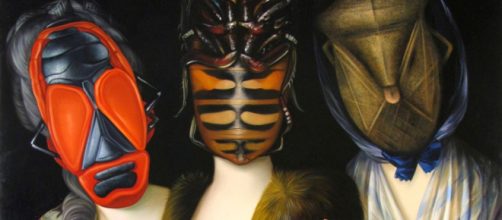Is there a shift in female artmaking emerging? Two unrelated retrospectives on both sides of the pond showcase headless or faceless females. That’s a lot of women rendered invisible by women.
Cherchez la femme
Of course, faceless, or headless women are not new in art history, but the effacing has been done by men. Edgar Degas is known for picturing women without describing their faces, as in his paintings of women in their bath.
No surprise there given Degas’ words are often quoted by art writers. Washinton Post art critic Sebastian Smee’s cited the words in a 2021 article about Degas’ painting of a woman in her bath called “The Tub.”
Smee invoked Degas’ famous words, “I have perhaps too often considered woman as an animal.” And when it comes to women in their bath, the artist explained that he sees that as “a cat licking itself.”
Showing women in an unfavorable light also showed up in Degas’ paintings of ballerinas yawning or scratching themselves.
But what accounts for a female artist doing the Degas thing to another female? Consider the painter Ewa Juszkiewicz whose works are on view at the Gagosian Gallery in Beverly Hills.
Where’s the rest of me?
Juszkiewicz doesn’t so much eliminate women’s faces as hide them. A New York Times headline gives you an idea of her ways of concealing: “Her Clothes? Fabulous. Her Face? A Fungus.” (Don’t ask).
Such facelessness is no small thing in Juszkiewicz’ work. Her paintings, which stress the clothes of finely dressed women, are giant-sized, nearly 10 feet.
And here’s the thing. These faceless women are not all that anonymous. Juszkiewicz paintings are recreations of portraits made in the 18th and 19th centuries.
She just leaves out the faces, replacing them with oddities like mushrooms and outlandish hairdos. Why?
She told the Times she’s demonstrating “the absurdity of period portraits of women.” By absurdities she means features like pink cheeks and porcelain skin. She sees these as masks that hide individuality.
At least Juszkiewicz has a reason for hiding women’s faces. Sculptor Sarah Lucas at Tate Britain, faulted in this space on Oct. 17 for beheading women, doesn’t seem to have an explanation.
But wait, even with Juszkiewicz’ reason, there’s a pitfall. An unenlightened public may see her pictures of faceless women in fancy clothes as some novelty fashion show. How many gallery goers will get her point that Old Master portraits rendered women as objects rather than people?
And given Juszkiewicz fantastical face coverings, won’t an unsuspecting public be taken in with her surrealist flights of fancy and miss her point that Old Masters objectified women? And by obscuring female faces, won’t viewers conclude that clothes make the woman?
In any case, what’s the difference between, say, Diego Velázquez’ “Rokeby Venus” of a nude Venus with her back to the viewer looking at a fuzzy mirrored reflection and Juszkiewicz’ obliterated faces or Lucas’ decapitations? All these artists keep women out of the picture.


